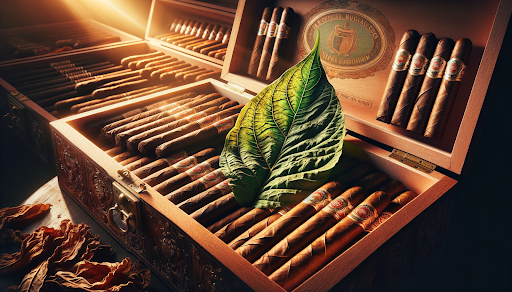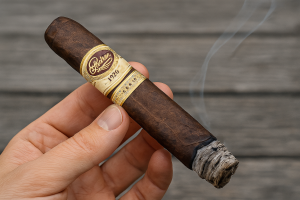How Do Tobacco Leaves Transform into Cigars: From Tobacco Field to Cigar Box in 7 Stages

The journey of tobacco leaves transforming into cigars is a meticulous process that combines agriculture, science, and craftsmanship.
This transformation involves several stages, each crucial for creating the perfect cigar.
This blog post delves into the stages of this transformation, exploring how tobacco leaves end up as premium cigars, and how this influences the quality of the final product.
Stage 1: Cultivation of Tobacco Plants as a Beginning of Leaves to Cigars Transformation
The first step in producing cigars is the cultivation of tobacco plants, primarily the Nicotiana tabacum species. The following are key points regarding cultivation:
- Climate and Soil: Tobacco grows best in warm, humid climates, such as the Caribbean, Central America, and parts of the United States (e.g., Connecticut and Kentucky). The soil must be rich and well-drained.
- Planting and Care: Seeds are usually started indoors and later transferred to fields. Farmers must monitor water, nutrients, and pest control carefully.
- Harvesting: Tobacco is typically harvested between 60-120 days after planting. Leaves are hand-picked, often at different times to ensure optimal ripeness.
Stage 2: Curing the Tobacco Leaves
After harvesting, the leaves must undergo a curing process to develop their flavors and aromas. This essential step allows the tobacco to lose moisture and undergo chemical changes that enhance its natural characteristics.
- Methods: The most common curing methods include air curing, flue curing, and sun curing.
- Air Curing: Leaves are hung in barns for weeks. This method is prevalent for producing certain types of cigars like those from Kentucky.
- Flue Curing: Heat and humidity are controlled to quicken the curing process. This method is commonly used for Virginia tobacco.
- Sun Curing: Leaves are sun-dried; it is the oldest curing method, mostly used for oriental tobacco varieties.
- Duration: The curing process can take anywhere from a few weeks to several months, depending on factors like the method used and the type of tobacco.

Stage 3: Fermentation of Tobacco Leaves
During fermentation, the tobacco leaves are piled to allow natural enzymes to break down chlorophyll and develop complex flavors. This process can take several weeks to months, with careful monitoring of temperature and humidity to ensure optimal results.
- Process: After curing, the leaves are placed in piles or bales to allow the natural enzymes to break down chlorophyll and develop flavors.
- Duration: Fermentation can last from a few weeks to several months, depending on the desired characteristics.
- Monitoring: Temperature and humidity are carefully controlled. The leaves are regularly checked and rotated to ensure uniform fermentation.
Stage 4: Aging the Tobacco
Once fermented, the leaves are aged to further enhance their qualities. This aging process allows the tobacco to mellow, deepening its flavors and complexities for a richer smoking experience.
- Purpose: Aging mellows harsh flavors and allows for deeper complexities to develop.
- Duration: Aging periods vary, commonly ranging from one year to several years, depending on the type of tobacco and the desired end product.
Stage 5: Sorting and Blending
After aging, the leaves undergo a meticulous process of sorting and blending. This crucial step involves carefully categorizing the tobacco by various characteristics, such as size, color, and quality, to ensure that only the finest leaves are selected for production
- Sorting: Leaves are categorized by size, color, and quality, known as “priming.” Higher quality leaf, such as ligero (the strongest), seco (medium), and volado (milder), can be combined.
- Blending: Master blenders create unique flavor profiles by combining different types of tobacco, ensuring consistency in production.
Stage 6: Rolling the Cigar
Rolling is where craftsmanship comes into play, requiring skill and precision from expert rollers known as torcedores. They carefully select and arrange the tobacco leaves, ensuring that each cigar is constructed to enhance the smoking experience.
- Types of Rolls: Cigars can be hand-rolled or machine-rolled. Machine-rolled cigars can be produced in high quantities, while hand-rolled cigars often exemplify craftsmanship and care.
- Process: Skilled rollers (torcedores) use their experience to wrap the filler leaves with a binder and final outer wrapper, which affects the overall smoking experience.
Stage 7: Packaging and Distribution
Post-rolling, cigars are carefully packaged to preserve their freshness and quality. This process often includes placing them in humidors, which help maintain the ideal moisture levels until they reach the consumer.
- Quality Control: Finished cigars undergo rigorous inspections for quality assurance.
- Packaging: Cigars are often placed in humidors to maintain moisture, crucial for maintaining freshness and flavor until they reach consumers.
The Fascinating Transformation Process of Tobacco Leaves into Premium Cigars
The transformation of tobacco leaves into cigars is an intricate process that combines art and tradition. Understanding each step allows cigar enthusiasts to appreciate the craftsmanship involved in making cigars.
And, ultimately, by having an idea of how these premium products are crafted, consumers can make informed choices when buying cigars and appreciate the nuances that come with each piece.















